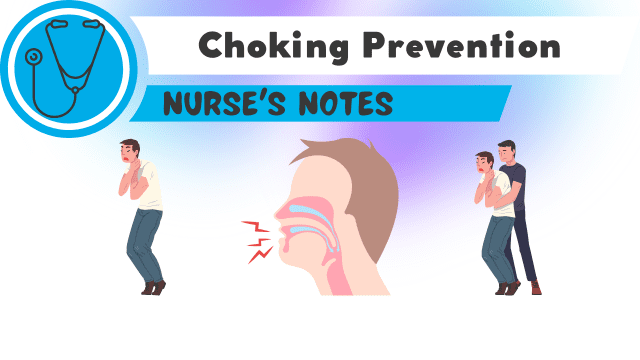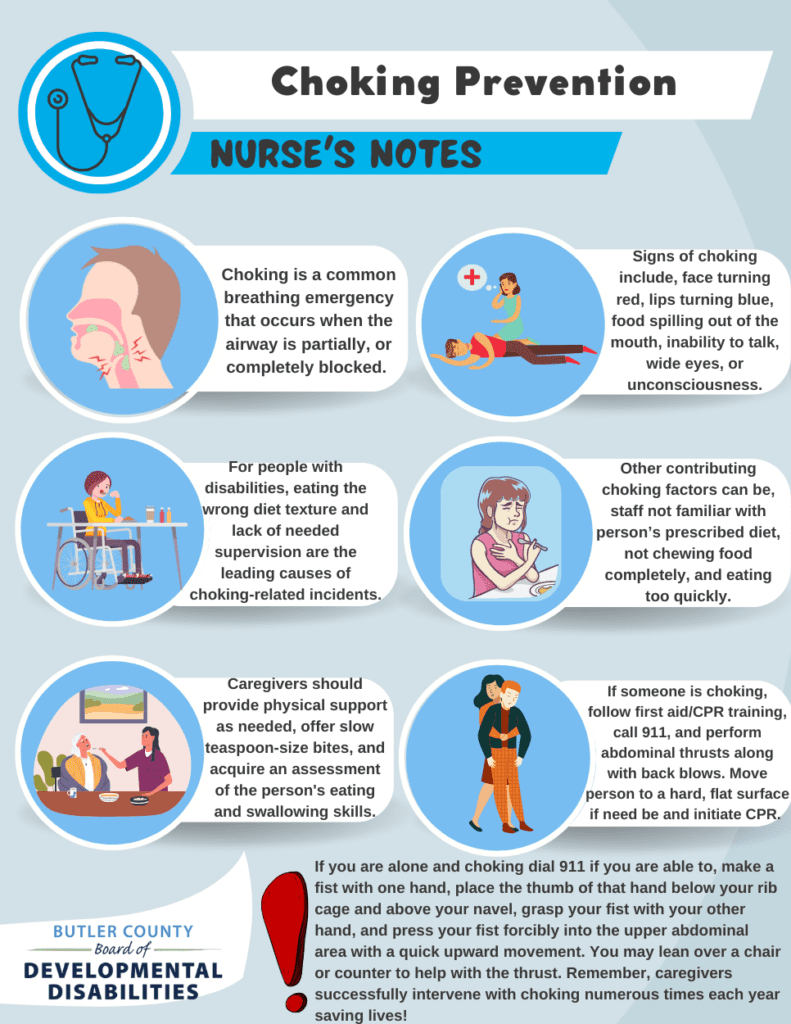
Nurse’s Notes: Choking Prevention
Every month, our staff nurses share important health updates. This month, our nurses are talking about how to prevent choking!
Choking is a common breathing emergency that occurs when the airway is partially, or completely blocked.
For people with disabilities, eating the wrong diet texture and lack of needed supervision are the leading causes of choking-related incidents.
What are some signs that someone is choking?
- Face is turning red.
- Lips are turning blue.
- Food is spilling out of the person’s mouth.
- Inability to talk or make much sound.
- Wide eyes and/or a panicked look on the face.
- The person may quickly leave the area, indicating they are experiencing a swallowing issue.
- The person is unconsciousness or appearing asleep.
What are some causes and contributing factors to choking?
- Staff is not familiar with the person’s prescribed diet, is not able to prepare the food, or is not properly assisting with eating and positioning techniques.
- Not chewing food completely.
- Eating too quickly.
- Talking or laughing while eating.
- Eating food that contains two or more diet textures, such as cereal with milk.
- Eating in vehicles.
- Taking some medications that affect the ability to swallow effectively.
Caregivers successfully intervene with choking numerous times each year saving lives, but PREVENTION IS KEY!
What can caregivers do to prevent choking?
- Provide physical support as needed to ensure someone is sitting upright while eating and up to 30 minutes after meals.
- When assisting with feeding, offer slow teaspoon-size bites, wait for the person to finish one bite before offering another, and remind them to tip chin down to swallow.
- Offer frequent sips of water or other clear beverage with meals to aid in swallowing and clearing the throat of food.
- Don’t encourage someone to eat if they are not alert to the task of eating.
- An assessment of eating and swallowing skills is needed and typically completed by an occupational therapist or speech language pathologist.
What to do if someone is choking:
- Follow First Aid/CPR training (The American Red Cross includes back blows as an intervention and the American Heart Association does not. Use intervention methods required by your training.)
- Call 911.
- If someone else can call 911, perform abdominal thrusts, formerly known as the Heimlich maneuver, along with back blows.
- For a person using a wheelchair or with a physical characteristic making it difficult to use the abdominal thrust, move the person to a flat, hard surface.
- Initiate CPR chest compressions to help unblock airway.
- If abdominal thrusts along with back blows is successful, immediately notify a health care professional for a physical check-up.
If you are alone and choking dial 911 if you can. Next make a fist with one hand and place the thumb of that hand below your rib cage and above your naval. Grasp your fist with your other hand and press your fist forcibly into the upper abdominal area with a quick upward movement. You may lean over a chair or counter to help the thrust.
Key things to remember about choking prevention:
- If the choking person can cough, encourage them to do so.
- If the object is visible in the mouth, attempt a finger sweep.
- If an adult has a completely blocked airway, give up to 5 blows between the shoulder blades with the heel of your hand.
- If blockage is not relieved, employ abdominal thrusts.
- Continue cycles of 5 back blows and 5 abdominal thrusts until object is coughed up or the person starts to breathe or cough.

